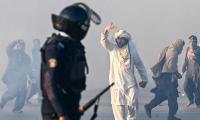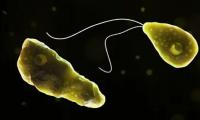HYDERABAD: Fishermen community at the Manchhar Lake takes the recent floods in rain river Nai Gaj as a blessing that will help rehabilitate the shrinking water body after long time. But there's a catch. These floods were not entirely natural.
Mustafa Mirani, a community activist, belonging to Boobak town, near the lake, said, “Mostly a large number of fishermen from the area always move to coastal areas, mainly Karachi and Sonmayani, Balochistan, to find better opportunities of earning livelihood”. “They usually stay there for six months, starting from September to February.”
This year, he expects that after the rehabilitation of their own habitat Manchhar, these fishermen may not have to migrate to other places, as the lake is not only receiving new fish seeds through the flood water but mature fish is also flowing into it from the fish farms after the flooding disaster.
The lake spreads over 233 sq-km area, out of which 75 percent area has received fresh water through Nai Gaj and other natural rivers flowing down from Balochistan’s distant mountainous areas.
Community people linked the situation with the previous 2010 River Indus floods in which many politically influential people had built their own embankments to divert the river water, disrupting its natural flow. As a result of the diversion the entire province had experienced huge economical losses with destruction and displacement everywhere.
The same situation has been witnessed in Nai Gaj, where influential people have used tractors and other earthmoving machinery to build their own embankments within the river for storing water for irrigation purposes. Besides this, a large number of families have also built infrastructures, creating new villages in the river bed, which the stream had destroyed, washing away each and every thing along with their makeshift abodes.
Niaz Sial of Basic Development Foundation (BDF), leading a farmers’ network in Dadu district, said, “The people in Kachho and Kohistan (arid zone) depend on these natural rain waterways for agriculture, storing water for drinking purposes through indigenous methods, and rehabilitating natural grazing fields”. “This is an old practice to utilise water equally to benefit all.” Sial said in the past there was no such greed as witnessed now. He said this year building of illegal infrastructures in the riverbed caused destruction and the fishermen’s families suffered losses as a result. “It is not natural but manmade disaster,” he added.
Pervaiz Bahooto, another community activist from Johi town, traditionally economical hub of Kachho, said, “For the last three days business activities in towns of Kachho have were shut down by the disaster amid fear and panic”.
Bahooto confirmed building of illegal diversions for river water through artificial dykes, which led to losses of infrastructure in the area.
He said many farmers as usual have cultivated cotton in the upper parts of the area. Other farmers have developed nurseries of onion, chili, and tomato as per routine practice and were preparing to cultivate these crops; however, floods wiped out all these including the solar-powered tube wells.
Bahooto said with solar-powered tube wells damaged, farmers war unlikely to cultivate their next immediate crops like sorghum and variety of pulses to recover the losses. The community activists believe that these people might have not expected this high level of water flowing through Nai Gaj and had established artificial dykes.
For this disaster, farmers also blame provincial irrigation department officials, who failed to take notice of these violations and take action to avoid disaster. Presently, the water level in Nai Gaj is receding from 16-ft recorded on the first day and has come down one or two ft by Monday. Law enforcing agencies personnel are helping the relevant department in rescue and relief operation.
Like this, officials associated with different non-governmental organisations are looking alert there, distributing food packs, medicines and other things. The affected people are seen crying for help, especially for their rehabilitation. There is also fear of outbreak of waterborne disease because of stagnant floodwater.
Reports show that communication networks have broken down and many villages on both the sides of the Nai Gaj were inaccessible and there was no word on their situation, despite efforts from different sides.
Hardly a week before the rains, the residents of Johi and other neighbouring areas were seen protesting for the availability of drinking water. The community people told The News that usually farmers of Kachho borrow from individual lenders to buy seed, fertiliser and renting ploughing machinery for next immediate crops; however, now the entire scenario has changed and people are experiencing hardships.
The residents of Wahi Pandhi town have also been disturbed due to disaster. According to people, who depend on the Manchhar Lake for livelihood, their source of income has shrunk due to ups and downs in terms of receiving freshwater. The lake had received more water during the 2010 flood, which showed signs of rehabilitation of the water body. But later the community people had faced problems because of receiving contaminated water through Main Nara Valley (MNV) Drain.
The longtime scarcity of water has put the livelihoods of both the growers and fishermen under threat. Hundreds of families from the community have migrated to different inland waters in Punjab and Khyber Pakhtunkhwa provinces and some have shifted to coastal areas in search of better living.
The environmentalists believe the natural calamities and disasters aside, political influence have contributed to create artificial water shortage and blockage of feeding streams of the freshwater lake, like happened in the Nai Gaj.
Now when the lake has received more fresh water due to flood, the fishermen activists demand of the government to provide new fish seed, which may help the local communities recover losses.
The image shows founder of Akhuwat Foundation Dr Amjad Saqib along with President and CEO of Faysal Bank Yousaf...
The logo of the Matco Foods Limited. — Facebook@matcofoods/FileKARACHI: Matco Foods Limited has entered into a...
A woman looks at a gold bangle inside a jewellery showroom at a market in Mumbai January 15, 2015. — ReutersKARACHI:...
Employees working at cargo ship Kypros Land which is loading soybeans to China at Tiplam terminal in Santos, Brazil,...
This undated image shows a policeman running past a burning vehicle in Karachi. — AFP/FileLAHORE: Rule of law in...
The Apple Inc logo is seen at the entrance to the Apple store in Brussels, Belgium November 28, 2022. —Apple Inc’s...







